|
How Reagan Sowed the Seeds of America's
Demise
By
 - March 30, 2010 - March 30, 2010
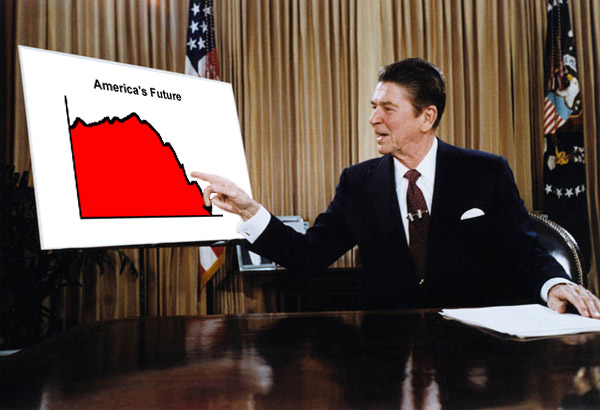
It has been over a year now since "The Great Recession" officially began,
and yet even a basic understanding of the real causes of America's economic
problems has still not emerged in the public. Indeed new movements have
emerged touting as solutions to our current economic problems many of the
very policy ideas that are actually the causes of our current economic
problems. The rallying cry of conservatives across America has been a
"return to the policies of Reagan!" The claim of many American conservatives
has been that Ronald Reagan faced similar economic conditions when he was
elected, and he was able to turn the economy around, so we need to return to
the principles he used to reinvigorate the American economy.
The reality is that the economic policies of the "Reagan Revolution" have
been in effect for the past three decades, and it is these very policies
that have caused the economic situation that America finds itself in today.
During his first
presidential campaign Ronald Reagan campaigned against government spending, he
campaigned on reducing the national debt, he campaigned for individual
responsibility, and he campaigned for broader American capital ownership.
The effects of his policies, however, had all of the exact opposite
effects, and yet amazingly even today the vast majority of all Americans,
especially conservatives, still believe Reagan's rhetoric and not the real
effects of his policies.
In 1980 Reagan campaigned against what he called "out of control" deficit
spending by the federal government. He identified the source of this "out of
control" spending largely as social welfare programs. Shortly after taking
office in 1981 Reagan gave a televised speech to the country in which he
stated:
"By 1960 our national debt stood at $284 billion. Congress in 1971
decided to put a ceiling of 400 billion on our ability to borrow. Today
the debt is 934 billion. ...
Here you see two trend lines. The bottom line shows the increase in tax
revenues. The red line on top is the increase in government spending.
Both lines turn upward, reflecting the giant tax increase already built
into the system for this year 1981, and the increases in spending built
into the '81 and '82 budgets and on into the future. As you can see, the
spending line rises at a steeper slant than the revenue line. And that
gap between those lines illustrates the increasing deficits we've been
running, including this year's $80 billion deficit. Now, in the second
chart, the lines represent the positive effects when Congress accepts
our economic program. Both lines continue to rise, allowing for
necessary growth, but the gap narrows as spending cuts continue over the
next few years until finally the two lines come together, meaning a
balanced budget. I am confident that my administration can achieve that.
At that point tax revenues, in spite of rate reductions, will be
increasing faster than spending, which means we can look forward to
further reductions in the tax rates....
Our aim is to increase our national wealth so all will have more, not
just redistribute what we already have which is just a sharing of
scarcity. We can begin to reward hard work and risk-taking, by forcing
this Government to live within its means. Over the years we've let
negative economic forces run out of control. We stalled the judgment
day, but we no longer have that luxury. We're out of time. ...
We can leave our children with an unrepayable massive debt and a
shattered economy, or we can leave them liberty in a land where
every individual has the opportunity to be whatever God intended us to
be. All it takes is a little common sense and recognition of our own
ability. Together we can forge a new beginning for America."
-
Ronald Reagan: Address to the Nation on the Economy, Feb. 5, 1981
The irony of this speech is that the national debt was not out of control
at all in 1981, in fact the national debt was at the lowest point it has
ever been since World War II in 1980. In the speech Reagan cited national
debt figures in raw dollar amounts, unadjusted for inflation and not tied to
GDP. Those figures are essentially worthless and no economist would ever use
them as a measure of the national debt. But presenting the national debt as
a problem was a means of justifying significant cuts in domestic spending,
which he framed as "redistribution".
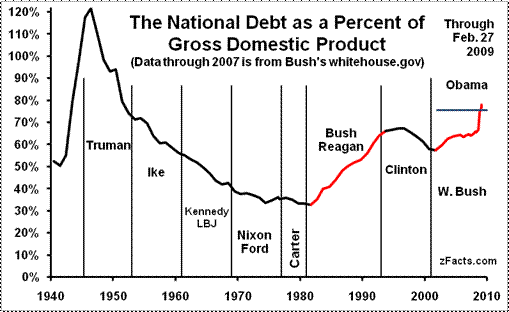
source:
http://zfacts.com/p/318.html
Reagan then went on to claim that by reducing income tax rates it would
increase the growth in income tax revenues, and that the principle of
reduced rates leading to increasing revenue would lead to a cycle of income
tax reductions resulting in ever growing income tax collections. In fact
federal tax collections under Reagan grew at the lowest pace of any post
WWII president and his successor George Bush was forced to raise taxes in
order to avert a total budget calamity.
The final irony of this speech is that today is indeed our judgment day
on the negative economic forces that Reagan himself unleashed. Reagan warned
against leaving our children with an "unrepayable" massive debt and a
shattered economy, yet at the time that Reagan took office the United States
was a nation of savers and the government had barely any debt at all. The
policies instituted by Reagan led to a massive ballooning of the national
debt and turned a nation of savers into a nation of debtors. While the
conditions that Reagan warned against did not even exist when he took
office, Reagan himself set the forces in motion that would bring about the
very conditions that he so direly warned against.
Not only did Reagan's policies lead to massive increases in the federal
debt, but household debt grew as well while personal savings declined.
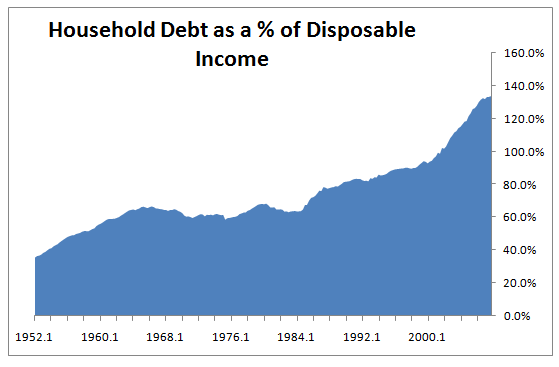
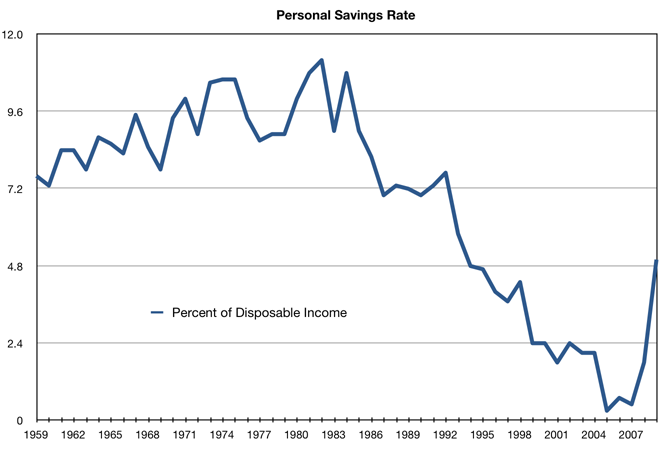
Of course there were real economic problems in America when Reagan took
office. When Reagan took office the unemployment rate was around 8% and it
peaked at 10.8% about two years into his presidency. Inflation was high in the late 1970s
as were interest rates. Indeed the high interest rates were a significant
factor in the high savings rates and low debt levels.
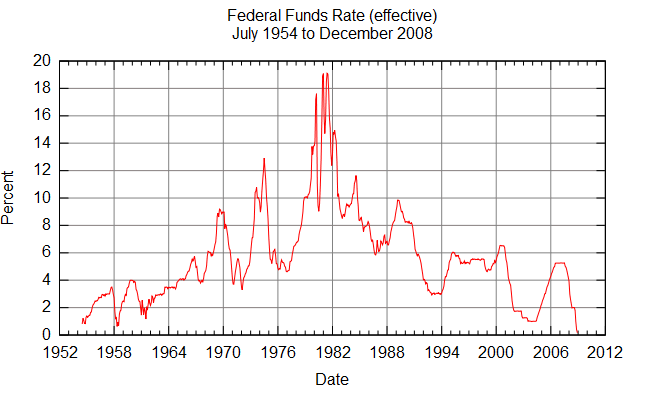
The economic problems, however, were largely driven by two factors: the
Federal Reserve's monetary policy and the energy crises of 1973 and 1979,
which were products of political hostility toward the United States for
American support of Israel and later due to the Iranian Revolution. The
energy crises led to high energy costs and fuel shortages across the
country.
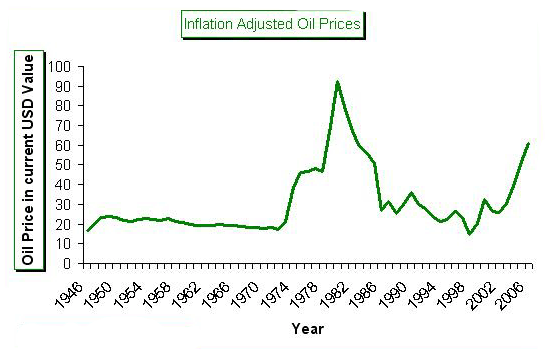
source:
http://www.uranium-stocks.net/uranium-how-high-could-the-price-go%E2%80%A6576/
So the major problems that the American economy faced were high
inflation, caused in large part by the rising energy prices, and high
interest rates, which were pushed higher by the Federal Reserve in order to
try and control inflation. When energy prices began to come down in the
early 1980s due to decreases in demand from lower usage and the adoption
more efficient products as well as massive increases in oil production by
non-OPEC and non-Middle Eastern countries, such as Mexico, Venezuela,
Norway, etc. this reduced inflation and allowed the Fed to reduce interest
rates.
Those two things, the resolution of the energy crises and the lowering of interest rates, were really the
most important factors in the economic recovery of the 1980s. But, of
course, that is not all that was done. The economic crisis of the late 1970s
served as a springboard to enact sweeping changes to the American economy.
Some of these changes, such as deregulation, were set in motion by Democrats
prior to the election of Ronald Reagan, while others, such as tax reforms,
were
most pronounced under the Reagan administration.
The most obvious changes enacted during the Reagan presidency were the
dramatic reductions in marginal tax rates. Reagan pushed for, and got from
the Democratic congress, significant reductions in capital gains taxes and
the marginal rates on payroll taxes. At the same time, Reagan pushed for,
and got, significant increases in Social Security and Medicare taxes, as
well as a number of other low end taxes. This was advocated by Reagan as a
means of broadening the tax base. Tax reform under Reagan was achieved
through a successive series of bills from 1981 to 1987, which saw the top
federal income tax bracket go from 70% in 1980 down to 28%, while taxes on
the bottom 80% of the country effectively stayed the same or increased
slightly.
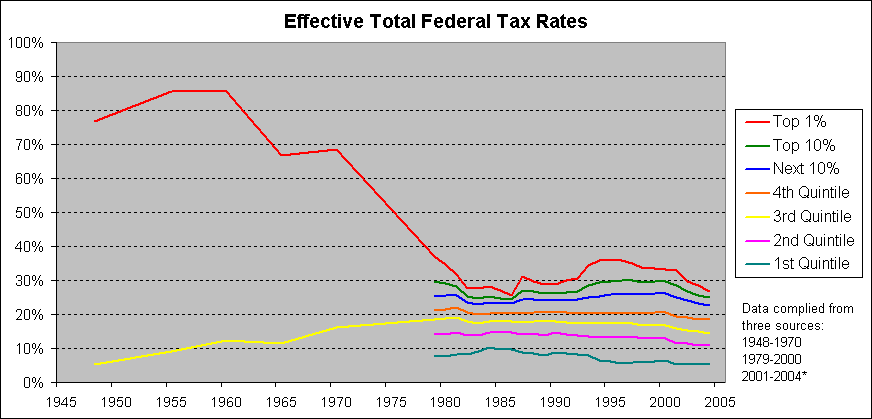
While the marginal federal income tax rate was 70% in 1980, there were a
number of loop holes in the tax code, allowing top income recipients to pay
significantly lower than 70% tax on their marginal income, however, the tax
reforms of the Reagan administration still resulted in significantly lower tax obligations on the high
incomes.
In addition to reductions on marginal income tax rates, capital gains
taxes were reduced from an effective maximum rate of 49.875% down to 20%.
The minimum 15% tax rate on capital gains was also eliminated under
Reagan. The tax rates were not just changed, but the entire tax code
surrounding capital gains was changed, shortening the period of time capital
had to be held in order to qualify for lower long-term gains tax rates in
addition to a number of provisions on the holding and realizing of capital
gains.
Corporate income taxes were also reduced under Reagan, to their lowest
levels since World War II at that time (they are now even lower).
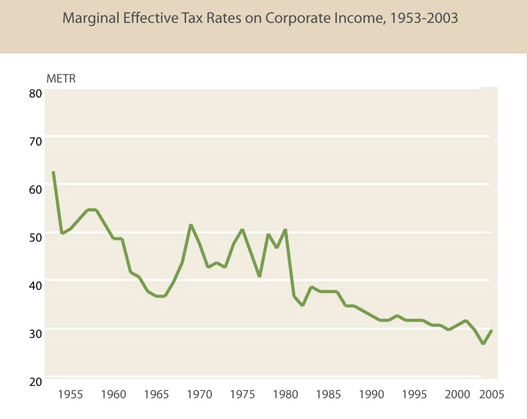
source:
http://www.taxpolicycenter.org/briefing-book/key-elements/business/what-is.cfm
Pressure for many of the changes that the Reagan era ushered in had been
building for decades. Indeed Barry Goldwater's campaign for President in
1964 (which highly influenced Reagan) can be seen as the political emergence
of the national movement against FDR's New Deal economy. Reagan made his
name early on politically by campaigning against government programs and
corporate regulation in the 1950s and early 1960s. When legislation for
Medicare was introduced in the early 1960s Reagan toured the country giving
speeches against it and recorded a speech for the American Medical
Association proclaiming that if Medicare is passed, "we will awake to
find that we have socialism. And if you don't do this, and if I don't do it,
one of these days, you and I are going to spend our sunset years telling our
children, and our children's children, what it once was like in America when
men were free."
Other changes were also already underway in the private sector as well.
The way banks were operating was already changing during the 1960s and
1970s, despite a lack of legislative changes, as many processes were
becoming more automated, efficient, and less expensive, leading to changes in
the scale and scope of banking and investment activity. Corporations in
general were getting larger and the percentage of people working for large
corporations was going up. Demands put on the financial sector grew as the
size of corporations and institutional investors grew.
Likewise, changes in the consumer marketplace were already underway by
the time Reagan was elected as well. The rise of large "big-box" discount
department stores began in the 1960s with companies like Wal-Mart, and this
market trend just happened to hit critical mass in the 1980s.
But while fundamental changes in the American economy were already
underway before Reagan ever stepped into office, Reagan further strengthened
corporate interests and helped clear the way for dramatic increases in the
consolidation of capital ownership. Other changes by Reagan and later
conservatives also greatly increased the power and influence of industry
groups and lobbyists in government as well. Furthermore, Reagan had perhaps
the most significant impact on public attitudes toward government and
private industry of any president since Franklin D. Roosevelt. While FDR
played a major role in shaping the public perception of government as an effective
champion of the people against tyrannical moneyed interests, Reagan
successfully portrayed government as a tyrannical force against the moneyed
interests of the people.
When Reagan famously said that, "government is not the solution to
our problem; government is the problem," in his First Inaugural Address
in 1981, he set the political tone for decades, a tone that persists to this
day. Reagan effectively framed government as an enemy of the people and the
wealthy as the saviors of the people, to whom the public was indebted.
There was certainly an undercurrent of racism in the white middle-class
anxiety that Reagan tapped into. There was a perception among middle-class
whites, especially in the South, that the federal government was benefiting
blacks more than whites, that it was effectively taking money from whites
and redistributing it to blacks. During his presidential campaign Reagan
told the story of a woman from Chicago, whom he called a "Welfare Queen". He
claimed that she had multiple aliases and was collecting over $150,000 a
year from the government. It turns out that no such
woman ever existed. Reagan did not specifically say that the woman was
black, but he described her in ways that fit existing black stereotypes, for
example claiming that she was from South Chicago (a predominately black
neighborhood) and drove a Cadillac. Reagan regularly portrayed the recipients
of welfare and food stamp programs as blacks and portrayed welfare programs
as a drain on the average tax payer's wallet. He identified public assistance programs as one of the sources of
the middle-class's economic problems, claiming that the middle-class was
effectively being bled dry by the poor.
This narrative connected with the white-middle class in part because
there had in fact been dramatic improvements in the African-American
economic condition during the 1960s in large part due to federal policies,
though in reality it had more to do with improvements in education for
African-Americans, Civil Rights legislation, and ending overtly
discriminatory policies towards African-Americans. Even though blacks were
still far behind whites economically in America, the economic status of
blacks did improve more rapidly than whites during the 1960s, largely
because they were so far behind to start with.
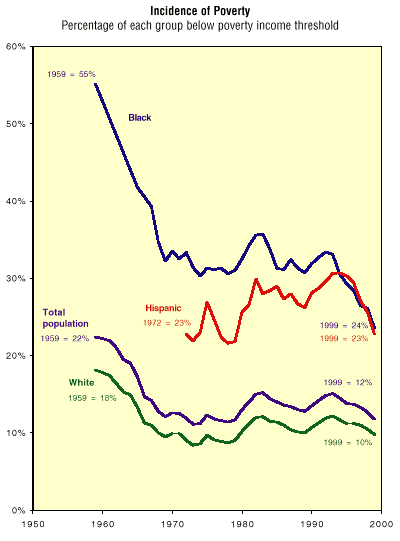
source:
http://www.pbs.org/fmc/book.htm
The reality is that federal government policies were
helping blacks. The integration of public schools, affirmative action, the
federal fair housing law, etc. all worked to improve the situation of blacks
in America, by combating unfair practices used against blacks. But
improvements in African-American economic conditions were portrayed by
conservatives as a zero sum game, in which black gains came at a cost to
whites, and this played a significant role in convincing many middle-class
whites that it was the poor who were holding them back and that the federal
government was the agent of this attack on the white middle-class.
The reality, however, is that government policy played a
major role in the creation of the white middle-class in the first place. A
number of financial and labor reforms that were put in place by FDR during
the 1930s played a major role in the building of the American middle-class.
The implementation of the minimum wage, the federal backing of labor unions,
federal housing loan programs, the G.I. Bill and other forms of financial
support for going to college, the expansion of the public school curriculum
with a focus on science and math, the subsidizing of cheap food, and the
overall stabilizing of the financial system all helped to build the American
middle-class. Whites also disproportionately benefited from many of these
policies as well, such as the G.I. Bill, and housing loan programs.
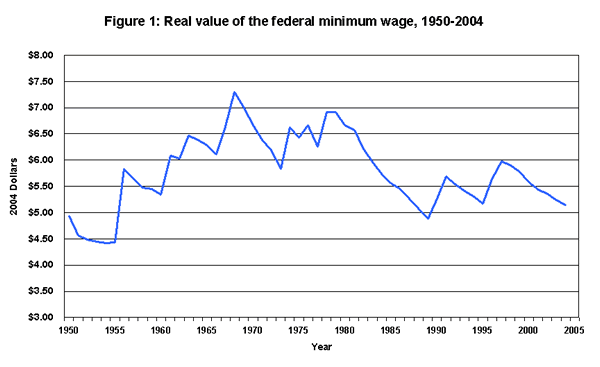
source: http://www.musfs.org/faq
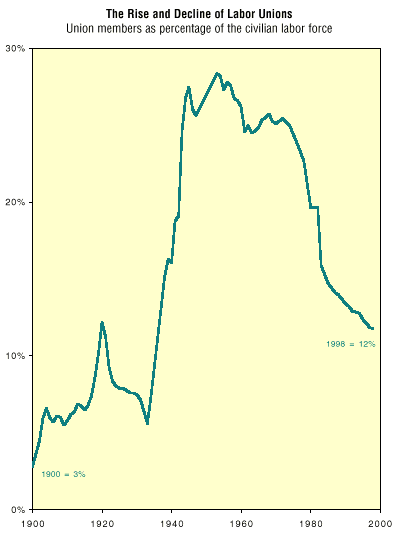
source:
http://www.pbs.org/fmc/book.htm
In addition, the rapid expansion of the nation's
infrastructure by the federal government from the 1930s through the 1960s
also had a dramatic impact on the economic development of the country. Again
this impact was greatest for whites, as areas of white population received a
far disproportionate level of development. Indeed white rural America was
the most disproportionate beneficiary of the infrastructural building boom
of the 1930s-1960s, with programs like FDR's
Rural Electrification Program, the
Tennessee Valley Authority, and road development programs transforming
thousands of isolated areas from areas with no electricity, no running
water, and and no paved roads in 1930 into places with electricity, running
water, paved roads, and telephones by 1940. The
interstate highway system commissioned by Dwight Eisenhower in 1956 literally paved the way, along with prior government initiatives, for the
rapid development of the middle-class American suburbs.
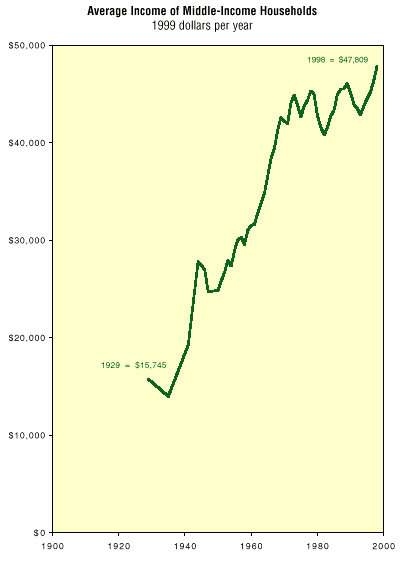
source:
http://www.pbs.org/fmc/book.htm
What is most striking about the household income growth shown above
(which shows median income) is that the number of workers per household has
been steadily increasing over the past several decades.
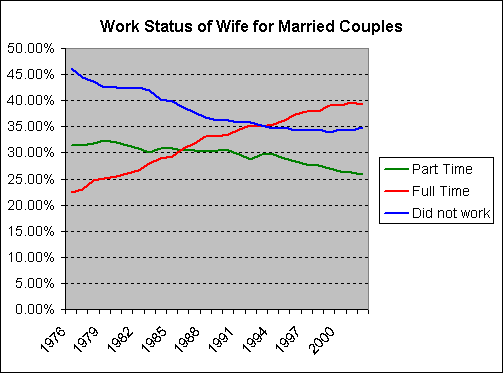
Indeed what little growth there has been in median household income from
the 1980s to present has been a product of the increasing number of workers
per household, not of increasing individual compensation, while growth in
median household income from the 1940s through the 1960s was predominately a
product of increasing individual compensation.
The fact is that the American middle-class was built from the 1940s
through the 1970s, and it has been in decline ever since. America as we know
it is a product of that period. Prior to the Civil War America had an
agricultural economy, in which wealth was relatively evenly distributed
compared to Europe, almost entirely due to the fact that the primary form of
wealth and capital was land, which was easily available, with many ways to
acquire it for free or at a nominal price from the government.
Industrialization began after the Civil War, and with industrialization
income inequality rapidly increased, except for a brief period shortly prior
to and during World War I (due to the growing labor movement and rising
labor prices). After World War I (and the Russian Revolution) the labor
movement was reversed in America, with laws against unionization, and labor prices began falling again.
During this time income inequality increased rapidly until the
administration of FDR. The period from the end of World War II through the
1970s was unique in American history in that it was the only time in
America's industrialized history in which there was prolonged egalitarian
economic growth, in which incomes rose at almost equal rates among all
income classes. Indeed the poor saw the largest gains during this time while
the wealthy saw the lowest.
It is this period that built the broad middle-class that defined modern
American society and laid the foundation for the future American economy. It
was during this time that the American middle-class was larger than it had
ever been, and has ever been since as a percentage of the population.
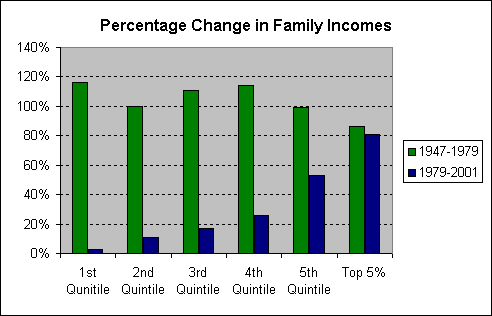
source:
http://www.faireconomy.org/research/income_charts.html
As we can see in the graph above, contrary to the popular claim that
Reagan's economic agenda would be a "rising tide" that would "lift all
boats", the real rising tide that lifted all boats was the period prior to
Reagan, whereas the post-Reagan era has seen gains skewed strongly toward the
wealthy. Because this graph shows household income, not individual income,
the modest increases in the 1st through 4th income brackets are also largely
a product of an increasing number of workers per household, not actual
individual gains.
As shown in the data below, the period after World War II and prior to
Reagan was a period when the share of national income going to the broad
base of the population grew the most, while since Reagan income
gains have gone primarily to the top1%.
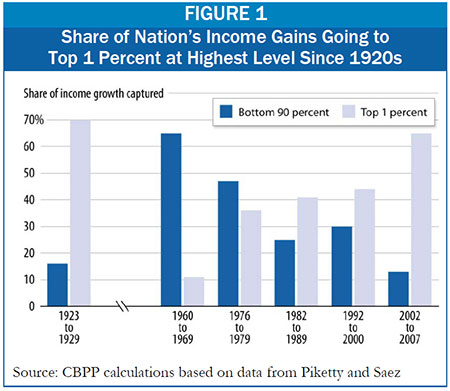
source:
http://www.cbpp.org/cms/index.cfm?fa=view&id=2908
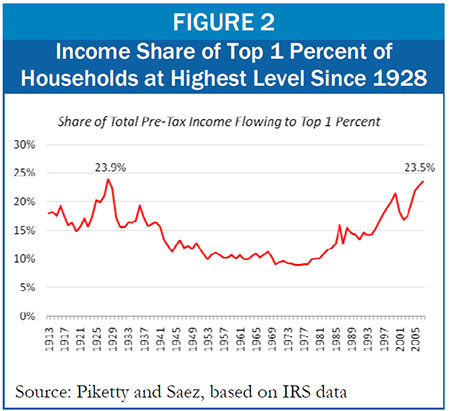
source:
http://www.cbpp.org/cms/index.cfm?fa=view&id=2908
Figure 3 below shows that not only was income growth much stronger for
the bottom 90% of the people in the period between World War II and Reagan,
but total income growth for the entire nation was also stronger during this
period.
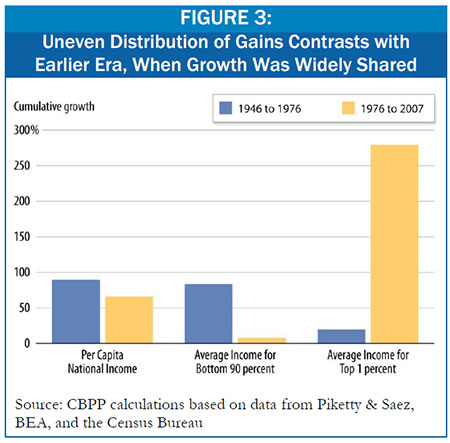
source:
http://www.cbpp.org/cms/index.cfm?fa=view&id=2908
So we can see that the period of most equal income distribution in modern
American history was the period between the end of World War II and the
entrance of Ronald Reagan into office. We can see that the period from the
end
of World War II to the end of the 1970s was a period in which the majority
of the economic gains went to the majority of the people and that in the Reagan
and post-Reagan eras the majority of the economic gains went to the
wealthiest 1% of the population.
That economic disparity in America has grown dramatically since the
"Reagan Revolution" is undisputed, but the question now is, why and how has
it grown?
The period since World War II has seen a relatively consistent upward
trend in Gross Domestic Product, or economic output. GDP growth in the
Reagan and post-Reagan eras is comparable to that from World War II up until
Reagan took office.
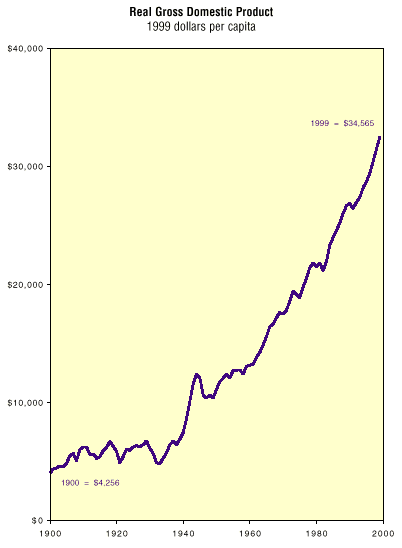
http://www.pbs.org/fmc/book.htm
Trends in economic growth have gone unchanged since World War II, so what
accounts for the radical change in the distribution of compensation that is
marked by the Reagan and post-Reagan eras?
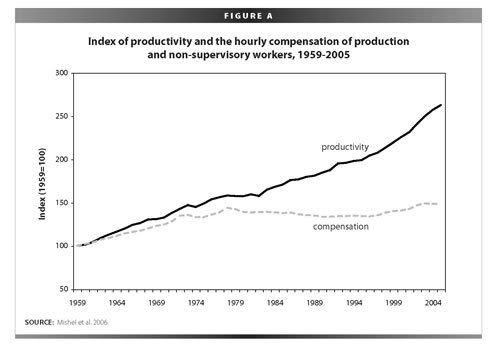
source:
http://www.sharedprosperity.org/bp191.html
The graph above is key to understanding the growing income inequality in
America. From the end of World War II through the end of the 1970s the gains
from increases in productivity were broadly shared among all segments of the
work force. Beginning in the late 1970s, however, and continuing on after
that, worker compensation leveled off and the additional gains produced by
increasing productivity went almost entirely to executives
and owners/shareholders.
There are a few different ways to explain this. One is to say that the
economy, driven by market forces, is accurately reflecting the relative
contributions of the different actors in the economy, and that its simply
the case that over the past 30 years all of the growth in productivity is a
product of capital and contributions from management, that essentially 90%
of the work force has made no contributions to the growth in American
productivity over the past 30 years.
That's one possible explanation. A second explanation is that the
compensation going to workers prior to 1980 was too high, i.e. that 90% of
the work force was over paid during the period between World War II and the
1980s, and that what we've seen over the past 30 years has been a market
correction, brought about by the fair and just reforms of the Reagan and
post-Reagan eras.
And yet a third possible explanation is that executives and capital
owners have unfairly been the recipients of all of
the economic gains of the past 30 years, at the expense of the majority of
American workers who helped to produce those gains. Productivity gains produced in part by workers have been
realized by executives and capital owners instead of by the workers
responsible for the gains.
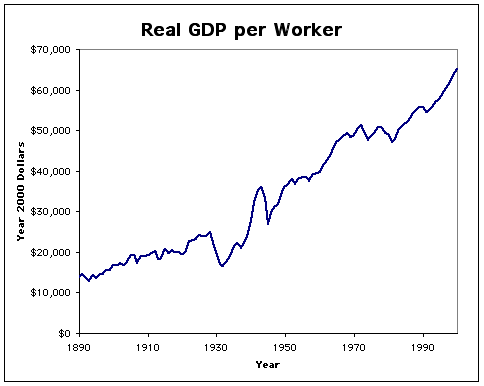
http://www.j-bradford-delong.net/TCEH/2000/TCEH_2.html
The first thing to understand is that worker productivity has steadily
risen in America since World War II, and has risen at roughly the same rate
since 1980 as it did between 1940 and 1970. If anything worker productivity
has actually risen faster over the past 30 years than it did during the 1960s
and 70s.
What our economy is telling us by the way that income has been allocated,
is that the rise in worker productivity over the past 30 years has been solely
a
product of capital and management, i.e. that managers and machines have
effectively produced 100% of the productivity gains of the past 30 years.
The only way that the income distributions of the past 30 year can be called
"fair" and appropriate is if that statement is true, but is that statement
true?
Well, the most obvious measure of the changing workforce is education.
One intuitively expects that a more highly educated work force would be a
more productive workforce. By this measure the contribution of individual
workers to increased worker productivity has continued to rise steadily over
the past 30 years, with the workforce becoming more highly educated with
each passing year.
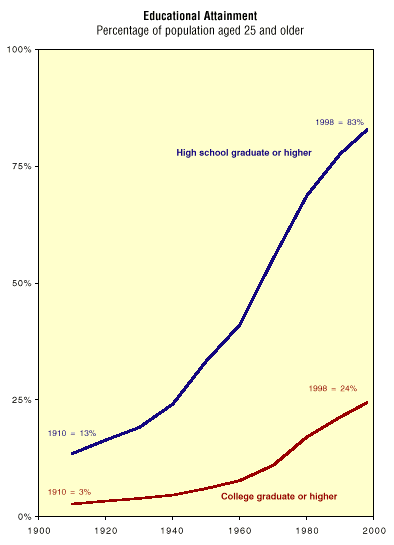
source:
http://www.pbs.org/fmc/book.htm
Not only has the workforce become more educated with each passing year,
but the investment of individual workers in their own education has also
increased steadily. Tuition and fees have increased far faster than the rate
of inflation or of average wages over the past 30 years.
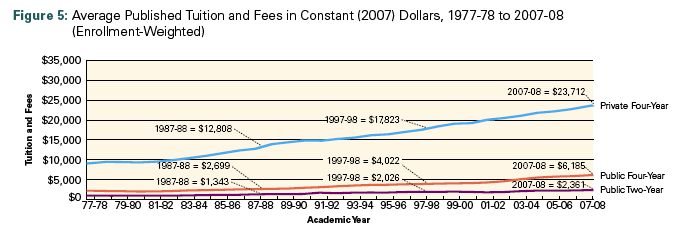
source:
http://www.collegeboard.com/prod_downloads/about/news_info/trends/trends_pricing_07.pdf
Although financial assistance has also increased over this same time
period, it has not increased at the same rate as costs, and so even with
increasing financial assistance students are still paying more for their
educations today than ever before.
So while education is more evenly distributed today than any time in American history, income is more unevenly distributed than just about any
time in American history. Not only are American workers more educated today
than ever before, but American workers pay more for their own education
today than ever before as well.
Furthermore, the vast majority of productivity gains deriving from
capital improvements, i.e. the development of better technologies and
systems, are products of the work of ordinary workers. For example the average
income for a computer programmer in the year 2000, the height of the
technology frenzy, was just $57,590, yet much of the productivity gains from
the 1980s on have been the product of broad systematic improvements made by
millions of "average" computer programmers. The same can be
said of all kinds of professions, from scientists to engineers to designers
to technicians to educators, all of whom are making real improvements to
capital, yet extremely few see any of the gains. There are also the
productivity gains that are simply a product of more efficient work
practices, which are products of education and training, and these gains
cross all professions and position levels, from office clerks, carpenters,
and fry cooks on up to managers and executives.
One of the major trends in income inequality that began in the 1980s was
dramatic increases in executive compensation. From the 1980s on, compensation
for the average American worker has barely kept pace with inflation, yet
compensation for executives running the same companies at which worker's pay
has barely kept pace with inflation have seen their compensation levels
increase by orders of magnitude.
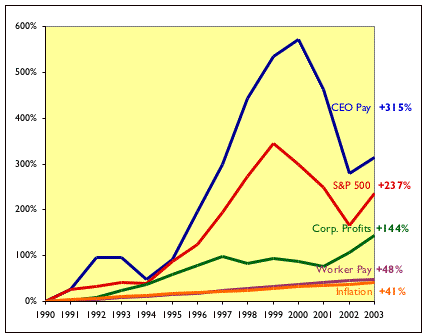
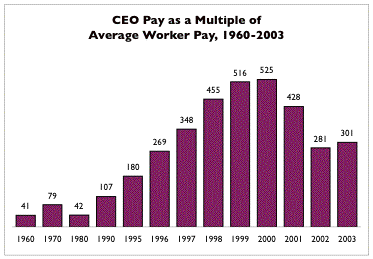
source:
http://www.faireconomy.org/research/CEO_Pay_charts.html
So what have been the real driving factors behind these enormous gains in
compensation by top executives, while the vast majority of workers have seen
no gains at all? Are these executive gains justified? Did executives all of
the sudden start creating vastly more value in the 1980s and 90s? Did
Reagan's deregulation, tax cuts for the rich, and other financial reforms
all of the sudden remove the chains of oppression holding top managers down?
As, William J. McDonough, chairman of the New York Federal Reserve Bank,
said in 2002, "I find nothing in economic theory that justifies this
development, I am old enough to have known both the CEOs of 20 years ago and
those of today. I can assure you that we CEOs of today are not 10 times
better than those of 20 years ago."
See:Fed
official decries CEO salaries
There are multiple contributors to this situation, which include the
massive increase in the off-shoring of American production, the decline of labor
unions, and changes in compensation practices by corporations.
As for the off-shoring, the income gains realized by executives from the
off-shoring of American production were essentially one-time gains. These
were effectively windfall profits made by the sale of American production to
foreign countries, i.e. they got rich from selling America out. Notice that
I'm not using the word jobs here, I'm using the word production, because we
aren't just talking about jobs. Even if these executives laid-off the same
number of workers and replaced them with robots and automated systems here
in America that would still be better than off-shoring. Yes, given the
current economic system it would still have led to growing income
inequality, but by off-shoring American production to foreign countries
these executives have not only eliminated certain jobs (arguably others are
also created) but they have also reduced American control over production of
the goods and services used by Americans, and not only have we lost some
degree of control, but we have also lost capital and not only have we lost
capital, but we have also lost the engine for further capital
development.
Growth in executive compensation due to off-shoring is essentially the
product of the elimination of domestic workers and replicating them with
foreign workers at a lower cost, with a portion of the difference being
awarded to executives. With American unions in decline, the ability of
workers to fight such moves or to bargain for better terms of release has
been diminished. Even if one argues that off-shoring creates new economic
opportunities in America, this still doesn't justify the compensation going
to executives for the practice, because those executives aren't the ones
creating the new jobs, their compensation bonuses come from the elimination
of existing ones, not from the creation of new ones.
But off-shoring and the decline of unions don't account for everything,
there are other major factors. Over the past 30 years executive compensation
has changed dramatically, not just in the amounts of the compensation, but
also the forms of it. During the 1980s and 1990s executive salaries increased
dramatically relative to average workers, but other forms of compensation
increased even more, such as awards of stock, severance packages, cash
bonuses, interest
free loans, use of corporate property, and short-term incentive bonuses.
Unlike compensation for other employees, executive compensation is often
governed by a board of directors, and that board of directors is typically
elected or appointed by share holders. But who are the shareholders?
Well, since the end of World War II the portion of US stocks held by
individual investors has been in decline, crossing the 50% mark in the
1980s. While the majority of stock was held by individuals from the end of
World War II until the 1980s, today individuals directly hold only about 30%
of US stock, the rest is held by institutional investors.
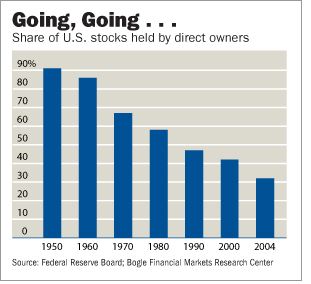
So what does this have to do with anything? Institutional investors have
different interests than individual investors and different perspectives.
Over the past three decades boards of directors have become more homogenous
as well, with more of the same people sitting on boards of different companies.
Institutional investors are now the primary electors and appointers of
boards of directors, and these investors are themselves wealthy. They are
more likely to support high compensation packages for executives and less
likely to take an interest in compensation for the average worker.
But there is even more to it than just that as well.
Executive compensation is also a form of protection against takeovers. In
effect, executives are paid in part simply not to destroy the company, i.e.
they are paid not to undermine the interests of the shareholders by
engineering undervalued corporate takeovers and things of that nature. In
addition, executives have significant control over share price by the manner
in which they report information. So executives are paid highly in part in
order to provide a disincentive to underreport information leading to lower
stock prices, which makes takeovers easier and less costly.
Now, in the 1980s and 1990s continuing deregulation of industries as well
as other factors made the environment ripe for takeovers. As a result the institutional shareholders appointed
executive compensation boards who worked in their
interest to highly compensate executives as a means of defense against
hostile and undervalued takeovers. As institutional shareholders became more
powerful, it led to an arms race, in which the threat of takeovers grew and
the defense against them grew as well.
Giving executives extremely high pay and golden parachutes (extremely
rich termination packages) was seen as form of insurance against hostile and
undervalued takeovers. The decline of unions also paved the way in this
regard as well, because union contracts also form as a protection against
hostile takeovers, but as unions declined this opened the door for more
takeovers, leading to the further pumping up of executive compensation.
So in this sense, executive compensation has very little to do with
reward for performance, it is simply a form of insurance, the price of which
got ever higher with deregulation and deunionization. But again that still
isn't the whole story, there was another aspect to this as well , which was
the ever decreasing interest rate.
With the Federal Reserve continuously lowering the interest rates this
also contributed to the building of leverage needed to engage in corporate
buyouts and consolidation. So what happened over the past three decades was
a snowball effect, in which concentration of capital led to the further
concentration of capital, and as an insurance against being undermined by
the executives in charge of all of this capital, the institutional
shareholders grossly overpaid them as a means of buying their loyalty.
There were side effects of this executive compensation as well though,
most of which the institutional investors were happy with. High executive
compensation and short-term bonuses, which have grown tremendously over the
past three decades, are engineered as a means to prevent executives from
undermining the company by causing the share price to be undervalued, making
the company ripe for a takeover. The converse is true as well, however, that this
type of compensation leads to inflation of stock prices due to overly
optimistic
reporting, as we should have all learned by the events of the past 10 years
since the initial dot.com bust of 2000 and the several busts and scandals
that have emerged since. But the investors didn't mind inflated stock
prices, especially since investment institutions typically work on a commission basis
and thus get paid more the higher the prices go.
In addition to all of this there was yet one more factor that I believe
contributed to high executive compensation, and that was the rising incomes
of "superstars" in general. The rise of superstars really began in the late
19th century with the rise of national newspapers and increasing literacy
rates. Each technological advance that made it possible to copy and
spread the performance of an individual to larger and larger audiences
without any additional work on the part of the performer increased the power
and wealth of superstars. Radio, movies and television have all of course
played important roles in the growth of superstars, but in the 1980s and
1990s superstardom was taken to new levels.
In the 80s and 90s the incomes of singers, musicians, and athletes
skyrocketed due increasing exposure, increasing power of the media channels
carrying their performances (caused by media company consolidation), increasing numbers of Americans consuming
programmed media, expansions of the roll of superstars into a wider range of
outlets, and importantly the growth of portable and home based forms of
media consumption, such as audio and video tapes, then CDs and DVDs.
And so a vast array of technological advances and corporate collusion led
to ever higher paydays for the superstar products of the entertainment
industry, all made possible by intellectual property right laws which
entertainment companies have successfully lobbied to strengthen over the
years.
As compensation for superstar entertainers grew, it was only natural for
the incomes of other types of so-called top performers to try to keep pace.
The result is that by the 1990s three major types of super income
receivers had a emerged: Corporate executives, entertainment superstars, and
investors. Of professional investors, hedge fund managers have stood out over
the past decade as receiving especially high incomes. (Hedge
funds are effectively unregulated private investment funds).

source:
http://www.visualizingeconomics.com/
As was the case in 2005, the income of celebrity superstars generally
even outpaced that of corporate executives, but the income of hedge fund
managers grossly overshadowed even that of celebrities, with the top hedge
fund manager in 2005 receiving an income of 1.5 billion dollars for the
year.
Even that income was greatly eclipsed in 2007, however, when the top
hedge fund manager had an income of 3.7 billion dollars and five hedge fund
managers had incomes of over a billions dollars each for the year.
Essentially all of this income was taxed at the lower capital gains tax rate
of 15% as well by the way.
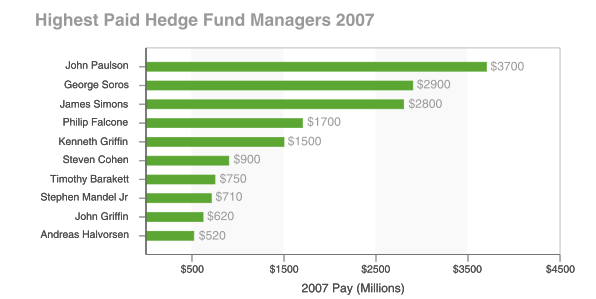
source:
http://www.visualizingeconomics.com/
What each of these types of income receivers (corporate executives,
celebrities, and investors) has in common is that their incomes are products
of collective systems. Celebrities are a bit different than executives and
investors, though in actuality the incomes of the top celebrities such as
Steven Spielberg and Oprah Winfrey are heavily reliant on control of capital
as well. The incomes of celebrities, aside from their investments, are
almost entirely a product of the technological ability to multiply an
individual's work so that a single unit of labor is amplified into millions
or now even billions of units of labor, with no extra effort on the part of
the "laborer". While technology provides the means to do this, it is
ultimately intellectual property right laws that allows celebrities (or
anyone else using such labor amplification technologies) to become wealthy
from their efforts.
Celebrities benefit from the fact that via technology they can put in one
day's work, say eight hours of work in a recording studio or movie set, and
have that work recorded and effectively turned into billions of hours of
work, and that there is a legal system in place which effectively turns that
recorded work into a form of capital, to which they (or their
producers/managers, etc.) retain rights.
Under this set of circumstances what happens is that enormous levels of
compensation are awarded to marginally "better" (in theory) performers. In
other words, those that come in first place get hundreds or thousands of times
greater rewards than those that come in second place, even though second
place may only be fractionally "less good" than first place. Thought about
in terms of a race, its like a situation where a first place runner runs a
mile in 4 minutes and is awarded $10,000 and a second place runner runs the
mile in 4 minutes and 5 seconds and is awarded $1,000, third place takes in
$500, and the fourth place runner who ran the mile in 4 minutes and 45
seconds gets nothing.
The first place runner receives 10 times more compensation than the
second place runner, but the first place runner isn't really 10 times better
than the second place runner. Likewise, the fourth place runner is only a
little slower than the first place runner, but gets no compensation at all.
This is similar to how celebrity incomes work, where the entertainment
market is dominated by a relatively small number of performers who are
really only marginally "better" than other performers (better in this sense
being judged by their ability to garner incomes) yet they receive massive
rewards for their marginally better contributions due to the fact that
performance amplification (i.e. recording and transmitting technologies)
creates a marketplace in which a small number of performers supply the
demands of exponentially larger numbers of consumers.
So celebrities are a little different than other types of high income
receivers, but their incomes are still rooted in control of capital and
their incomes are also still products of redistribution from social systems,
in which their single units of labor are transformed into many units of
labor by technology which can only be supported by the actual labor of thousands,
millions, or billions of other workers. If not for the wealth created by
other workers, celebrities would have nothing, as the products of their own
individual labor by itself is meager.
Executives are the most obvious beneficiaries of collective systems,
however, as
they sit directly at the tops of collective pyramids. A corporation is a
collection of individuals working together to create value. Executives
typically create little or no value themselves directly. The incomes of
executives have to come from the collective pool of wealth created by the
workers in the corporation who produce tangible assets. All of the income of
executives is effectively a product of redistribution from the producers of
tangible assets to the executives.
Value that is paid to executives is value that was created by other
workers in the corporation, but was not paid to them, and was instead
redistributed to the executives, and as such, each dollar paid to executives
represents in real dollars a loss of income to the workers who produced it.
This isn't to say that executives are worthless and deserve no income, they
do perform services that, in theory, when done correctly, benefit the other
workers at the corporation, and thus of course they deserve some
compensation.
Executive compensation has risen so dramatically over the past three
decades not because executives started producing more value, however, but because
control of capital has become more important and more powerful, and as the
heads of corporations executives are the ones who control the capital. Their
incomes are a product of capital control, not of their contribution to value
creation. In other words, their incomes are a product of position, not
production.
As for investors and investment managers, all of their income effectively
comes from capital gains. All capital gains are a product of work done by
other people. Without employees working there would be no capital gains.
Large investors are the ultimate beneficiaries of collective systems and
socially created value. Celebrities benefit from the technological ability
to turn their form of work into a type of capital that allows a relatively
small amount of work to be exponentially expanded into a means of receiving
value from millions of people, but at base their own work is the root of
their wealth.
Executives benefit from the value collectively created by workers at the
corporations that they sit atop.
But large investors benefit from value created by millions or billions of
workers around the word. All forms of investment income, i.e. rents,
interest, dividends, and gains from the sale of capital, are only made
possible by value created through work. If people don't work then value is
not created and rents don't go up, capital is useless, and there is no value
from which to pay dividends, etc.
In this sense investment income: rents, interest, dividends, etc., are
all forms of taxes on labor. The income of the investor is not generated by
the investor, the income of the investor is generated by other people, and
then transferred to the investor via the legal system. If other people don't
work then the investor won't have an income.
This is the difference between value created by an individual vs. value
transferred to an individual. For example if a farmer has a family farm that
produces 100 eggs, 10 gallons of milk, 20 lbs of meat, and 50 lbs of
vegetable a day, then that family is producing that amount of value each day
regardless of anything else. That is clearly value created by them and no
one else. If everyone else in the world decided to stop working and the
economy totally crashed and no one bought anything from anyone else, that
family would still be producing that value and would still benefit from it.
This isn't the case with investment income however. With investment
income, none of the value is produced by the investor, and all of the income
is dependent upon collective value creation and social systems.
If an investor invests $1,000 in a business on a condition of a 10%
annual dividend (on a condition to get paid $100 a year), and then the
workers decide to all just quit, then no value will be created, the company
will fail and the investor will lose his investment and will get no income
from it.
Investors provide a service by effectively sharing capital, but incomes
from investments are dependent upon other people using that capital in ways
that generate new value, some portion of which is then taken from the
creator of the new value and given to the investor as compensation for the
service provided by investing.
There is nothing fundamentally wrong with capital gains/investment
income, a.k.a. unearned income, the issue however comes in its distribution,
and recognizing that
investment income is not representative of value that is created by the
recipient, rather it represents value that was created by other people.
Obviously, however, people, especially those with high incomes, receive
income from multiple sources. Celebrities don't just have income from their
own performances, executives don't just have income from the compensation
they get from their position. The fact is that almost all of the income for
the wealthiest Americans comes from investment income.
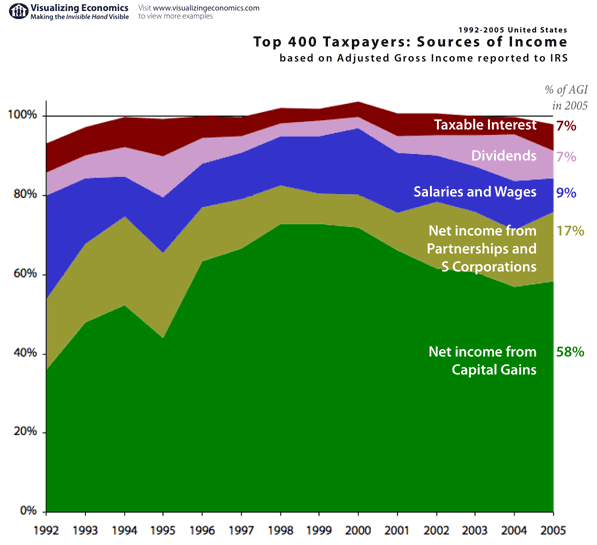
source:
http://www.visualizingeconomics.com/
The vast majority of the income of the wealthiest individuals comes from
investment income, because this is the only way that such high incomes can
be generated. Again, high incomes are generated through investments not due
to the contributions of the individual investor, but because investment
income is a product of collective wealth generation, whereby value created
by millions of people is transferred to single individuals.
Consider the $3.7 billion income of John Paulson the hedge-fund manager
in 2007. In order to argue that John Paulson actually "earned" that income,
one would have to argue that John Paulson himself created $3.7 billion worth
of value for the economy, for which he was compensated. If this were true,
it would mean that John Paulson created as much value as 73,656 average
working Americans with incomes of $50,233 in 2007. This would be to say that
John Paulson created more value than most moderate sized American cities in
2007. Is that reasonable? Of course not, because John Paulson didn't cerate
$3.7 billion worth of value, he extracted $3.7 billion worth of value
without having created it and without even having created anything close to
it.
But what about entrepreneurs, like Bill Gates, Michael Dell, Sam Walton,
etc. these people really have made major contributions and created real
value over the past 30 years. Yes, this is true, but again the level of
their compensation still far exceeds the level of their individual
contributions. None of these people personally created billions of dollar
worth of value. They all played important roles in the development of
systems that were used by other people to create billions of dollars worth of
value, but they themselves did not create that value, yet they as
individuals received billions of dollars worth of compensation.
It's not to say that entrepreneurs like this shouldn't be highly
compensated, but it is to understand that the levels of compensation
received by entrepreneurs in the 1980s and 1990s were not a product of their
own making, it was a product of their ownership of rights to value created
by other people in corporations that they founded.
For example Michael Dell began building computers in his own dorm room in
college, where he got his start in the industry. Those computers were
computers that he personally created and income from selling them represents
value directly created by him. He went on to ultimately become the CEO of his
own company, Dell Inc., which sold high quality low cost computers that were
manufactured in Malaysia and China. Michael Dell's wealth comes from the
sale of millions of computer systems and components, none of which were made
by him. His wealth was made possible by the fact that he was able to have
computers built in Malaysia and China by underpaid workers. Without
those Malaysian and Chinese workers building the cheap computers there would
have been no Michael Dell, he would never have become super wealthy.
Again its not to say that Michael Dell didn't deserve high compensation
for his contributions to developing a supply system for affordable American
computers, but the level of his compensation from Dell Inc. was
unquestionably a product of the value created by thousands of other workers
around the world. Without those workers building the computers Michael Dell
could never have become wealthy. The level of his wealth was a function of
the effective tax levied on the value created by those workers. His ability
to levy that tax on the value creation of others is a function of capital
ownership laws in both the stock directly owned by him and in his
compensation as a CEO, determined by a board of directors, put in place by
stock holders (including himself).
The point is that everything comes back to capital ownership and control.
The very high incomes in America and other capitalist countries are all
products of capital ownership. Very high incomes are not the product of
individuals working harder to produce more value than others, they are the
product of ownership rights to capital which effectively draw income from
the value produced by thousands or millions of workers in America and around
the world. So all of the highest incomes in America (and generally around
the world) are products of massive systems of collective production, in
which significant portions of collectively produced value is funneled to a
relatively small number of people. Millions, and ultimately billions, of
people creating value, significant percentages of which are funneled to a
few thousand people is what makes the wealth of the world's richest people
possible.
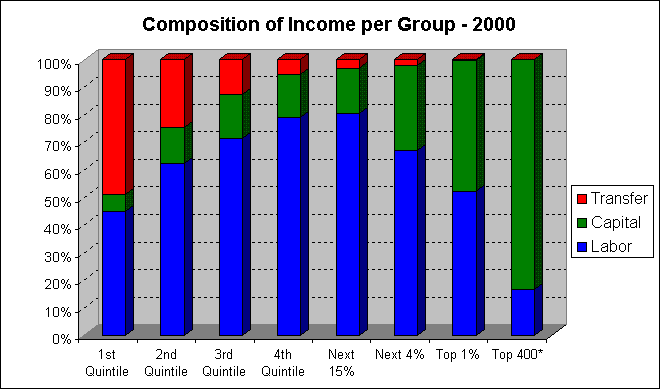
When we look at a breakdown of income type by income group, its clear
that the wealthiest Americans receive a significantly higher portion of
their income from capital than the vast majority of other Americans. As a
side note, "transfer income" refers to income from government programs, such
as Social Security, unemployment insurance, income assistant, etc. While
transfer income obviously makes up a larger portion of income for low income
groups, in fact the total amount of transfer income received by all income
groups is about the same, with the top 1% actually receiving among the
highest amount of transfer income per person.
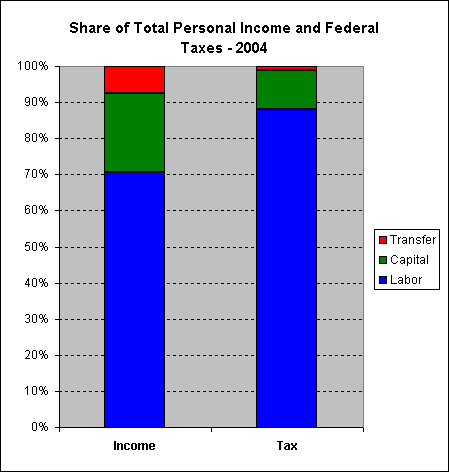
When we look at the distribution of income vs. tax receipts by type,
however, we see that despite the fact that capital income is by far the
primary form of income for the wealthiest Americans, the tax burden falls
disproportionately on income from labor. As of 2004 the form of income that
is most heavily concentrated among the wealthy was taxed the least, while
the form of income that was dominant among working class Americans is taxed
the most. This has actually been the case ever since the so-called Reagan
Revolution. The extent to which capital income was taxed in relation to
income from labor fluctuated in America throughout the 20th century, but for
most of the 20th century it was agreed that it was "unfair" to tax
"unearned" income, i.e. income from capital, at rates significantly lower
than earned income, or income from labor. The tax burden on capital was
significantly reduced during Reagan's presidency and has been reduced
further since his presidency in following with the trends established during
the Reagan Revolution.
Despite rapid growth in the number of Americans owning stock over the
past 30 years, the reality is that there is continued and growing disparity
in capital ownership and investment income. Yes, more Americans
own at least some form of stock today than ever before, but this hasn't
translated into more equal distribution of capital ownership overall or of
investment income. In fact, the wealthiest Americans receive a larger share
of investment income today than any time in American history, aside from
just prior to the market crash of 1929.
Share of capital income received by top 1% and bottom 80%, 1979-2003
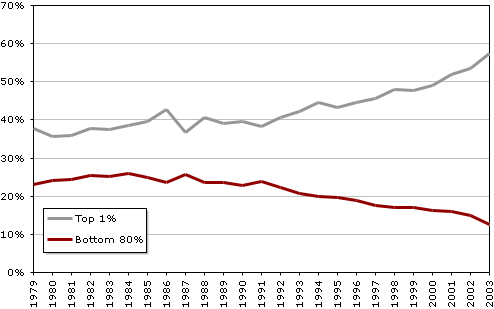
source:
http://sociology.ucsc.edu/whorulesamerica/power/wealth.html
There are multiple reasons for this. Yes, more people own some stock
today than ever before, but the amount of stock (including mutual funds)
owned by most American stock holders is very small, less than $10,000, while
the wealthiest Americans own billions of dollars worth of stocks each. In
addition, the majority of stocks owned by Americans in the bottom 80% of the
income population are owned inside of retirement plans like 401(k)s and
IRAs. What many Americans don't realize is that income from these retirement
plans is taxed as though it were wage income, it is not taxed at the lower
capital gains tax rates. The idea that around half of Americans "own stocks"
is used to support the low capital gains tax rates, when in fact the only
people paying those rates are individuals who generate income from
investment outside of retirement plans, which is almost exclusively wealthy
Americans.
So while about half of Americans own stocks, the majority of those
Americans are taxed at the higher wage rates on their investment income
because most American's investment income comes only from their retirement
plans. Likewise, with the growth of individual retirement accounts since the
1980s, it means that more of the capital that individuals do own is locked up
in retirement accounts, and is thus not a source of income for most Americans
until after age 65. The only people with meaningful investment income prior
to retirement are wealthy Americans.
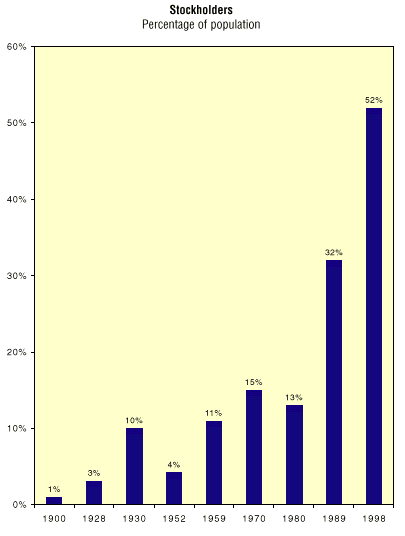
source:
http://www.pbs.org/fmc/book.htm
As can be seen in the graph below, despite a significant increase in the
number of people owning at least some stock during the 1990s, there was
really no impact on the distribution of stock wealth. Yes, more people
bought into the stock market in the 1990s, but the share of stock wealth
owned by the wealthiest Americans nevertheless stayed the same or increased
over this period.
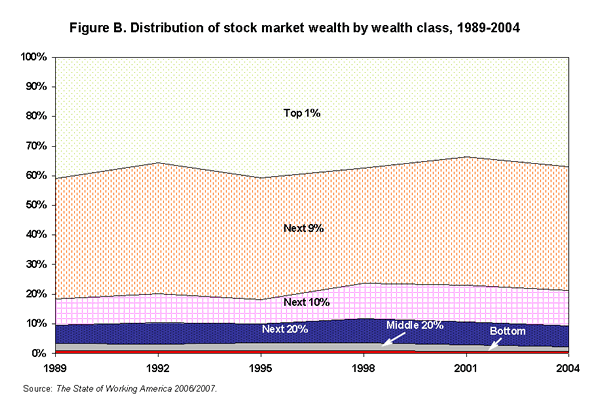
Furthermore, the so-called democratization of stock ownership has not
lead to democratization of capital control, because despite the fact that
more Americans own stocks today than ever before, the vast majority of that
stock ownership is through mutual funds which are controlled by
institutional investors, who in the end gain greater control and
influence via the use of other people's money. More Americans today own some
kind of investment, but far fewer stocks are owned directly by individuals,
and average individuals who do directly own stocks own such small amount
that their voting rights are meaningless, so while more Americans have
investments in the stock markets today than in the past, Americans as a
whole have actually lost ownership influence among publicly traded
corporations.
And the situation is even worse when it comes to private corporations and
small businesses. The percentage of Americans owning a meaningful business
today is lower than ever before. Yes, the number of small businesses has
gone up significantly in America over the past two decades, but this growth
in business entities is misleading. There are two primary drivers of this
growth, what I call "micro-businesses" and also a growth in the creation of
separate business entities for legal and tax purposes, which are actually
owned by parent corporations.
What I call micro-businesses are side businesses that people establish
for minor part time work, but these businesses are not primary means of
income, and they often report no income at all for years, with many people
running micro-businesses with yearly incomes of less than $5,000 a year.
These are side businesses for things like computer consulting, selling
self-published books, selling arts and crafts, etc. There is typically
little or no meaningful capital associated with these businesses. The
reality is that more people work for large corporations today than ever
before, and during the past 30 years there has been a significant decline in
real small business ownership. By a "real" small business I mean a business
that actually supplies an individual or family with their primary income.
Small businesses like individually owned restaurants, hardware stores,
pharmacies, grocery stores, clothing stores, mechanic shops, fabrication
facilities, furniture manufacturing shops, repair shops, etc., have all diminished
significantly over the past 30 years as capital concentration has lead to
the dominance of large corporations in these and other fields. So, even with
growth in the percentage of Americans owning stock, one has to consider that
the percentage of Americans owning their own privately controlled capital
has gone down. In other words, while the percentage of Americans owning
small fractions of public corporations has gone up, the percentage of
Americans owning their own meaningful capital has gone down significantly.
As a society, Americans have less control over capital today than ever
before. Average Americans own and control less of their own capital today
than ever, and what capital is owned by average Americans is largely owned
through financial institutions who practice the actual control over the
capital.
Conclusion and Summary
It is widely acknowledged by economists and political scientists that the
economic policies of the United States over the past 30 years have been
highly influenced by the economic agenda of the Reagan administration, both
by Reagan himself and by the multitude of politicians and scholars and
appointees that came to power during his presidency. Throughout Reagan's
life and political career he railed against government programs, economic
regulations, and taxation. This began with his political speeches in the
1950s and continued throughout his career. Yet when Reagan became president
in 1980 he talked about "restoring America", but restoring America to what?
Restoring America to how it was prior to World War II? That isn't what he
meant and it isn't what conservatives meant when they talked about restoring
America. Reagan had railed against the policies of the 1940s and 1950s back
in the 1950s, and he continued to do so in the 1960s, yet the "Golden Age"
of the American economy was the 1940s-1960s, with the large middle-class
that was built through the policies that Reagan railed against.
In the 1980s Reagan talked about restoring America, yet his policies were
designed to do the exact opposite economically, they were designed to undo
the America that middle-class Americans had come to think of as the "good
ole days" to which America would be restored. The America of the 1940s and
50s was an America of a strong central government, with a highly regulated
economy, built through the extensive use of federal programs and massive
federal subsidization of the white middle-class. And that is what it was
really all about. "Restoring America" always meant "restoring white
dominance", yet it could never really be admitted that the white dominance
of the 1940s-1960s was itself a product of government programs.
What happened in the 1960s and 1970s was that discriminatory practices by
the federal government and state governments were challenged and the
benefits of government programs began increasingly going to blacks and
minorities in the way that they had only gone to whites previously. When
this happened a new narrative emerged among conservatives, a narrative that
was echoed by Reagan, and which became a fundamental national belief when
Reagan came to power in 1980. This false narrative was that the white-middle
class had established itself all on its own, not with the help of the
federal government, but indeed despite the obstacles put in its way by the
federal government.
You see, once minorities began receiving many of the same benefits from
the government what whites had enjoyed for decades, one could not simply say
that blacks shouldn't be able to get the same benefits as whites, and one
couldn't acknowledge that whites had gotten where they were with the help of
those same benefits. For those that opposed minority access to government
benefits the convenient narrative was that whites had never needed such
benefits in the first place and therefore no one should have them now.
This was a core aspect of how the American federal government became the
enemy of post-World War II conservative America. The government was seen as
good by the vast majority of whites in the 1940s and 1950s, when the
government was almost exclusively helping middle-class whites. When
government policies began adopting measures of fairness so as to give the
same benefits to minorities that it gave to whites, then the white
middle-class was easily turned against such policies.
But this merely opened the door for the adoption of broader "free-market"
policies and ideology. Many of the so-called "free-market" policies of the
Reagan era weren't readily supported by the white middle-class, but the fear
stirred up by conservatives that government involvement in any shape or form
might lead the incomes of whites being taxed away and given to undeserving
minorities, or that government programs would in one way or another help
blacks at the expense of whites, was enough to push many middle-class whites
to support economic agendas that they otherwise would not have.
While Reagan and conservatives railed against government debt and federal
spending, the policies of Reagan and the Republican party as a whole brought
about unprecedented levels of deficit spending that had not been seen since
World War II. Reagan came in to office lamenting what he called an
unsustainable national debt, yet by the time he left office the debt had
almost doubled as a percentage of GDP (and had far more than doubled in raw
dollar terms). Not only had the debt of the federal government been pushed
to its highest point in decades by Reagan's policies, but personal debt grew
significantly as well.
Conservative defense of growing income inequality was simple, the basic
claim was that voiced by Milton Friedman, which was that the standard of
living was improving and that was all that was important.
In the particular problem of inequality, what is true, what is unquestionably
true, is that there's been a widening difference in wages earned. You have had
the skilled wages go up relative to the unskilled wages. However, there has been
no comparable widening in the levels of consumption. If instead of looking at
income, you look at levels of consumption, if anything that's become more equal.
The fraction of families that have a dishwasher, that have a sewing machine,
that have a television set. In respect to consumption, it's very hard to avoid
the view that people have been getting more equal rather than more unequal.
Milton Friedman, 2000:
http://www.pbs.org/fmc/interviews/friedman.htm
The fact that an economist like Friedman could acknowledge that there was a
disparity between consumption levels and income levels and not acknowledge
the obvious implications in terms of debt is astounding, and yet it was also
quite typical. Free-market economists since the time of Reagan flat out
failed to address the fact that economic stability and the ability of the
middle-class to support the economy is inherently tied to income inequality.
That as income inequality increases the stability of the economy decreases
and the ability of the middle-class to support the economy decreases.
Friedman always failed to acknowledge the fact that the growth seen in the
American economy from the 1980s through the end of the century was propped
up by unsustainable levels of personal debt, deficit spending, an ever
increasing number of workers per household, and one time gains from the
exporting of American production to foreign countries.
And this is the issue that the majority of people continue to fail to
understand today. The American economy of the past 30 years has always been
unsustainable. Conservatives today talk about the "economic miracle" that
occurred under Reagan, but the fact is that economic growth was modest under
Reagan, and what economic growth did take place was largely a product of
borrowing. The economy of the past 30 years has been built fundamentally on
debt and other unsustainable trends, such as lack of investment in
infrastructure and constant reductions of interest rates to fuel the debt
dependent economy.
But at a certain point, when interest rates get too low, borrowing itself
begins to greatly distort the economy, as we saw in spectacular fashion with
the housing bubble of the 2003-2007. The ability to borrow cheaply leads
economic actors into making decisions that they would not otherwise make.
And this played a significant role in the ballooning of executive
compensation as well, as the ability to borrow cheaply, combined with
deregulation, brought about an environment of excessive corporate takeovers
and mergers, leading to the rise of "defensive" compensation practices for
corporate executives, who were given compensation packages completely out of
line with their contributions in part as a defense against hostile
takeovers.
And while the trend toward concentration of capital ownership and control
was already underway prior to Reagan, the economic policies of Reaganomics
opened the flood gates instead of strengthening the dam, leading to an even
more dramatic rise in capital concentration over the past 30 years than
would have otherwise been the case. The concentration of capital ownership
by institutional investors added further fuel to the income disparity fire,
with institutional investors acting in ways that individual middle-class
investors previously had not. This helped pave the way for the massive
off-shoring of American industry in the 1990s, during the time of cheap
fuel, cheap borrowing, and institutional investors who were cozy and
comfortable with executives but not workers, who pushed executives to take
actions that would lead to greater market volatility and short-term gains,
both of which were beneficial to "investment" institutions, while they are
not particularly healthy for long-term economic stability and growth.
The result was that many people got rich quick during the 1980s and 1990s,
while their very actions were leading to the overall demise of the American
economy. Indeed the system of incentives that emerged from the Reaganomic
agenda is one that has driven the country into a downward economic spiral
as those driving the economy into the ground benefit from its destruction.
One of the biggest economic ironies of the past 30 years has
been the belief among conservatives, famously voiced by Reagan, that
"government is the problem", and the claim that government spending
inhibits economic growth, when in fact two of the technologies that
contributed the most to real economic growth in America over the past 30
years were developed by the government: the internet and satellite
technologies.
The internet is the type of technology that is very unlikely
for the private sector to ever develop, because when the internet was being
developed there was no immediate commercial intention for it. Furthermore,
it's something that took decades to develop and we know that during this time
there was no similar private network being developed, and if some company
had developed similar technology they would have made it proprietary and
intentionally not open in the way that the internet is today. It is the
openness of the internet that has made its economic impact so huge.
One of the other major technologies upon which real economic
growth was produced over the past 30 years is satellite technology,
primarily satellite communications. Telecommunications as we know it today
would not exist without the major pioneering of satellite communications
technologies by the federal government and the N.A.S.A. space program in
general. Today everything from G.P.S. to telecommunications to weather
forecasting to the entertainment industry owes a debt to decades of
government research and funding for the development of the technologies that
make modern information transmission possible. The internet and satellites
are quite arguably the most important technologies of the past 30 years,
upon which huge segments of our modern economy are based, and these are both
technologies that were fundamentally developed by the American federal
government, with the next closest rival being the government of the Soviet
Union, not free enterprise.
It was only after these technologies were developed to a
working and proven level by government programs they were then adopted,
exploited and expanded upon by private industry.
While many economists and pundits talk about how long it
will take to recover from the current recession and for the American economy
to return to its "normal operation" of the past 30 years, they fail to
recognize that the economy hasn't been operating "normally" for the past 30
years in the first place. The reality is that the demise of the America
economy began some 30 years ago. The seeming decent functioning of the
economy these past 30 years has been an illusion propped up by public and
private debt, and basically by riding on the solid base that was built in
this country during the 1940s-1960s. The solid economic base that was built
during that time, both in terms of the middle-class itself and in terms of
infrastructure and institutions was so strong and so well built that it was
able to carry the country for several decades even as it was being weakened.
The policies of the Reaganomic agenda reduced investment in the nation's
infrastructure, reduced investment in education, reduced investment in
long-term research and development, and instead squandered resources on
grossly over-funded military spending and on privatization schemes that
resulted not in the shrinking of the size of government nor in the
improvement of government services, but rather in the development of a
private sector with a profit motive to continuously get its hands on more
and more tax payer money.
Turning the government into a contract broker that funnels
taxpayer money to private for-profit companies is not a way to reduce
government spending, indeed it inevitably insured increased government
spending, as the privatization schemes of the past 30 years have proven.
There is a reason that government spending never went down with the private
outsourcing of government work, because by getting private companies so
heavily involved in the running of the government it inevitably did not lead
to more efficient and effective government, it led to a government
controlled by the private sector, which the private sector has become able
to use as a tool to increase profits. The private sector works well when it
is truly fully private, and the public sector works best when it is truly
fully public. It's when you give the private sector large scale access to
public funds that corruption and complications inevitably take place,
yielding results far worse than what either the private or public sectors
would produce independently.
The fact of the matter is that the policies of Ronald Reagan
and his ideological supporters in office have directly led to the ballooning
of public and private debt in America, to increased income inequality,
deterioration of the nation's infrastructure, and the weakening of the
American middle-class. The economy of Reagan was always an illusion. The
real economic growth that has taken place since 1980, and there definitely
was some real economic growth, owed much of its success to the solid
economic and technological base that had been built in this country in large
part by the federal programs of the 1940s-1960s.
Not only has the economy of these past 30 years been largely
propped up by debt and by a lack of engaging in the spending necessary to
truly sustain and grow the country and the economy long-term, but the
undoing of many of the tools for the promotion of economic fairness that had
been in place from the 1940s through the 1970s also means that a minority of
the population has benefited immensely at the expense of the working class.
Not only has a small minority of super-wealthy Americans benefited
disproportionately from the value produced by the American economy as a
whole, but this disparity in income and wealth growth has itself undermined
the economy and exacerbated American economic instability.
The incomes of the wealthiest Americans these past 30 years
has been flat-out unearned and undeserved. It is the largest case of
redistribution of wealth in this nation's history with the exception of the
original redistribution of land from the Native Americans and the wealth
gained through the use of slavery. It is a redistribution of wealth from the
middle-class and working poor to the super-rich. Value created by working
Americans, and indeed by workers around the world, has been taxed away from
the working class, not by the government, but by capital owners.
This redistribution of wealth is at the heart of the
economic problems in America today, it is the root cause of the housing
crisis, it is the root cause of the rise in household debt over the past few
decades, it is the root cause of funding problems for Social Security and
Medicare, and it is most definitely the root cause of the corruption of the
American political system. As the middle-class becomes relatively less
wealthy the middle-class loses political power. Income and wealth inequality
always coincide with political corruption and power inequality. Not only
have the wealthy, empowered by the Reagan Revolution, stolen value produced
by the working class over the past 30 years, but they have taken the
political power away from the middle-class as well in the process, and this is
Ronald Reagan's true legacy, and it remains to be seen if America can
survive the harvest of what Reagan sowed.
|